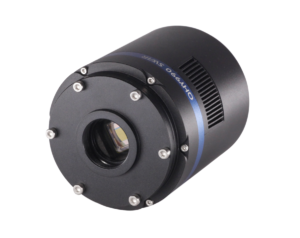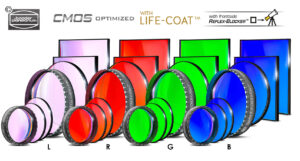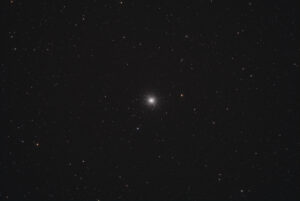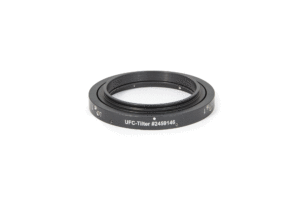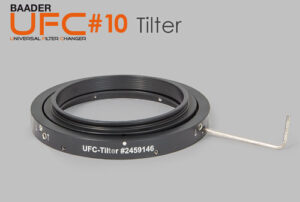Baader Planetarium Blog Posts
-
A compact and lightweight scope for guiding: QHYCCD's miniGuideScope
This entry was posted on October 1, 2021 Last modified on October 6, 2023.
A lot of people who undertake astrophotography, whether they are beginners or seasoned amateurs, opt for high quality small aperture, short-medium focal length telescopes such as BAADER APO 95/580 CaF2 Travel Companion (#2300095 , € 4495,-) or the 8" Celestron Rowe-Ackermann Schmidt Astrograph. These telescopes will give a relatively wide field of view allowing images to be taken of spectacular large celestial objects such as the North American Nebula, Andromeda galaxy, Orion nebula, Pleiades open star cluster and many many more. Guiding is essential for taking long exposure images of such celestial objects. Long gone are the days when your guidescope was a telescope that would be similar in focal length as your imaging scope and you would guide by looking at a star through...
-
Product announcement : SWIR QHY990 and QHY991 cameras
This entry was posted on October 1, 2021 Last modified on February 28, 2024.
Two new cooled CMOS cameras QHY 990 and QHY 991 for the near infrared spectrum. In September 2021, QHY began shipping 2 new camera models, the QHY990 and the QHY991. Both are cooled cameras with CMOS sensors covering the near infrared wavelength range. Both models use Sony InGaAs sensors with square pixels measuring 5µm x 5µm. The IMX990 is a 1.3-megapixel sensor and the IMX991 has a 0.4-megapixel array. The spectral response starts at 400. and ends at 1700 nanometres. The maximum quantum efficiency is 77 % at a wavelength of 1200 nanometres. More details about SWIR QHY990 and QHY991 can be found on our product page
-
Baader L-RGB Filters – CMOS-optimized
This entry was posted on October 1, 2021 Last modified on October 6, 2023.
A brief introduction to the function of CMOS/CCD (L)RGB Filters Unlike terrestrial objects, astronomical objects shine in discrete emission lines. For this reason, any RGB-filter design with gently raising and falling slopes on either side of the transmitted spectral region generally is undesirable. The stars themselves obey to the laws of physics and shine by their stellar temperature colour - with a smooth, wide spectrum. This richness of colours can be covered nicely when adding an L-filter into the imaging process. However – shades and colour hues such as in earthly objects are not available when imaging the sharply defined emission spectra of deep sky objects. For this reason the slopes on RGB filter curves ought to be produced extremely steep for each colour channel -...
-
Why is the Neodymium Filter only 1mm thick
This entry was posted on May 11, 2021 Last modified on February 28, 2024.
Kundenfrage: Why is the Neodymium Filter only 1mm thick? For me, this is a problem because a) focusing and (much important) b) backfokus, sinc I have the filters between coma corrector and camera sensor. Will this change with the coming CMOS-filters? Or can you already offer an alternative (I have got an 8" F4)? Thank you very much! Answer: First of all, the Baader Neodymium (Moon & Skyglow) Filter (various versions available) is primarily an absorption filter (just like the Semi-Apo filter), which reduces light pollution by neodymium ions in the glass melt which absorb the especially troublesome parts of the spectrum. Additionally (and in contrast to all copies which are offered nowadays) it has the dielectric coating of the L-filter (= UV/IR block filter),...
-
How do I adjust tilt and achieve micron adjustment with the FCCT, the UFC and M68 Tilter?
This entry was posted on January 21, 2022 Last modified on February 28, 2024.
Each tilter essentially consists of 3 pairs of opposing set screws which independently move the inner tilt mechanics and are easily accessed from the side using the included hex key (Allen wrench). These screws have tapered and hardened points that bear against a precision hardened ‘zero-clearance’ steel-counterpart. The direction that each set screw moves the tilter is shown with an etched arrow next to the individual screw. On the FCCT the extra-long hex-key with handle also serves as torque-control against overtightening. As soon as the handle starts to rotate (to "flex") without continuing to turning the screw then the maximum torque allowed is reached and instead of continuing to increase pressure on that screw, the other screw in that pair first must be unlocked by a very small amount....
-
My QHY filter wheel stops and cannot be positioned, what can I do?
This entry was posted on January 27, 2022 Last modified on February 28, 2024.
Within the last year (2021) we had twice the case that the pressure spring which holds the stepper motor in the filter wheel was too strongly tense, whereby the connection motor/filter wheel placed the rotating filter wheel somewhat crookedly, so that the wheel had ground at housing. As soon as this tension was reduced by stretching the pressure spring, both filter wheels were running again. We hope that this factory defect, which is obviously very rare but does occur, could also be the case with you. We apologize for the error and your trouble. Customer reply: We can report that the defect mentioned regarding the blocking of the filter wheel was obviously indeed due to the spring. We have opened the filter wheel as well...
-
Baader SunDancer II H-Alpha Filter – Test Review
This entry was posted on September 8, 2021 Last modified on February 20, 2024.
I was lucky enough to be able to "play" with one of the first SunDancer II H-alpha filters and see what it is capable of. Even though I am not one of the most experienced H-alpha observers, I have been able to observe the sun with the two H-alpha telescopes of the Observatory in Heilbronn/Neckar again and again for more than 20 years. These are a 20/20 H-alpha filter by Wolfgang Lille with 0.8Å on the 150/2250 refractor (which complements a classical prominence filter), and a Lunt LS-60 telescope. I freely admit that I find the concept of the Lunt convincing, especially for public observatories: a complete telescope with which nothing can go wrong. It's foolproof, which is especially important in an club where many...
-
New Products August 2021
This entry was posted on August 11, 2021 Last modified on February 28, 2024.
Important addition to the Baader UFC and M68 system Baader UFC-Tilter UFC tilter for an optimally flattened field of view Compatible with the entire Baader UFC system 0-1° tilt – allows a shift of up to 1° to compensate for misalignments in the image field 9.75 - 10.50 mm optical length On our overview page for the Baader UFC system, we have published some blog posts that explain the system clearly for a better understanding of the system. Baader M68-Tilter M68 titlter for an optimally flattened field of view Compatible with the entire Baader M68 system 0-1° tilt – allows a shift of up to 1° to compensate for misalignments in the image field 9.50 - 10.25 mm optical length Accessories for the M68...
-
The Baader UFC Tilter Adapter (Part 10)
This entry was posted on July 22, 2021 Last modified on February 27, 2024.
Baader UFC Tilter The effects of image tilt can ruin an otherwise great astrophoto. Image tilt (or image plane tilt) happens in imaging when an area towards the edge of the field exhibits out-of-focus or imperfect star images and is caused by the image sensor not being pefectly perpendicular to the light path. Focuser skewness (or "droop"), flattener/corrector lenses, extension adaptors, camera angle adjusters as well as inherent camera sensor tilt in the camera body itself are all causes of image field tilt. Being able to correct for this image plane tilt is important and essential to get perfect focused sharp star images across the field of view. For those that do astroimaging with our Universal Filter Changer (UFC) we are pleased to annnounce a...
-
QHY Adaptersets
This entry was posted on July 5, 2021 Last modified on October 6, 2023.
QHY offers a very comprehensive and flexible adapter system that allows our cameras to achieve focus with a variety of accessories, including camera lens adapters, off-axis guiders, filter wheels and numerous optical systems. The many potential combinations of these items produce an equally large variety of back-focus distances that must be considered to make it all work together. This variety and flexibility, however, also can be confusing particularly for new users.This is one of the reasons why we at Baader Planetarium keep receiving customer inquiries on the subject of "How do I adapt my QHY camera to my telescope?" How do I adapt my QHY camera to my telescope? If you use a refractor, a Schmidt-Cassegrain or a Newtonian telescope WITHOUT any other special optical...


